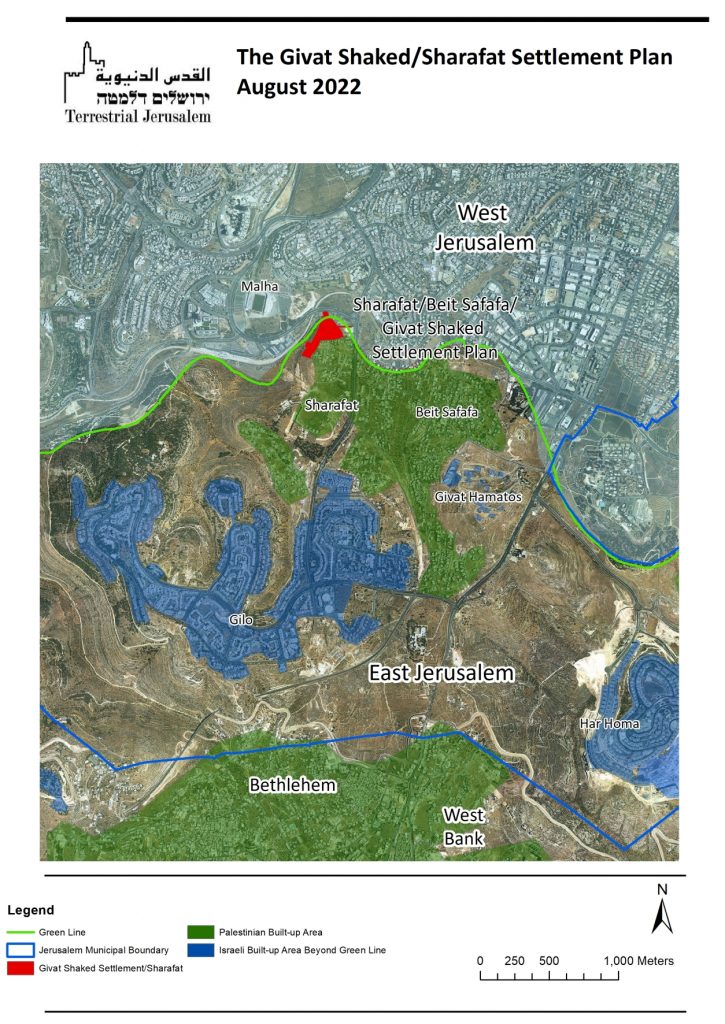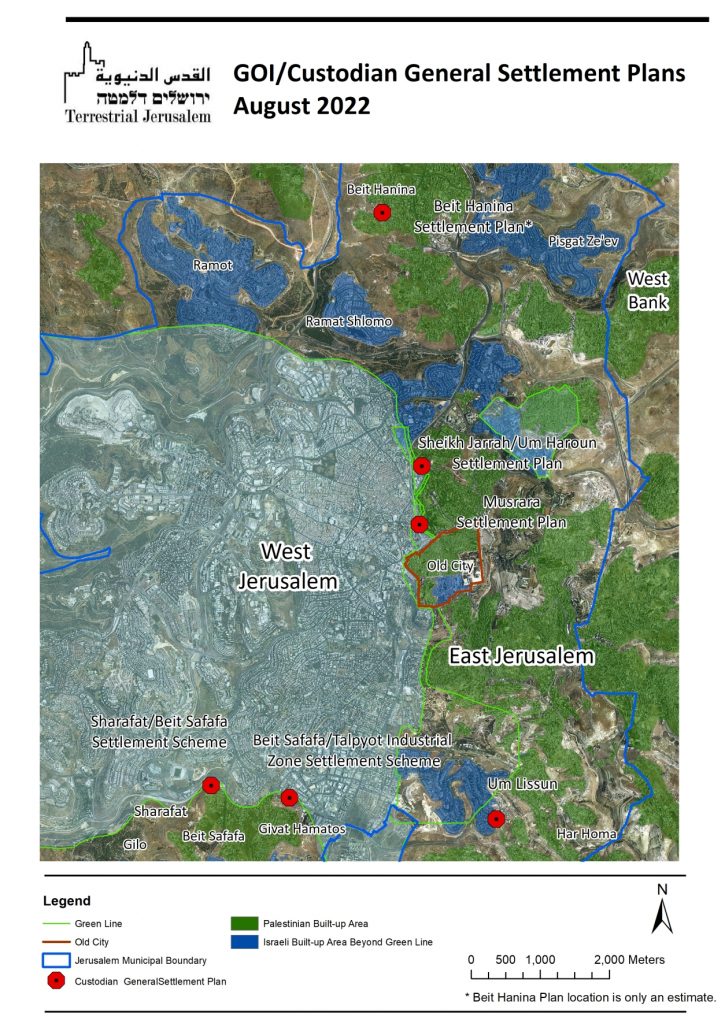This update covers three settlement plans currently on the agenda, their respective status and the implications if advanced.
- Givat Shaked/Sharafat
- The Lower Aqueduct Plan
- E-1
- Givat Shaked/Sharafat
Givat Shaked is a new settlement located beyond the Green Line on the northern slopes of the Palestinian neighborhood of Sharafat/Beit Safafa. It entails the construction of more than 700 settlement units, as well as schools and two synagogues on 38 dunams of land. If established, this will be the first Israeli settlement to be built inside a Palestinian neighborhood (on the lands of Sharafat) undertaken directly by the Government of Israel.
The Latest Developments
- On July 25, 2022, the Jerusalem District Planning and Construction Committee convened to deliberate on the plan for the establishment of Givat Shaked. With an original capacity of 473 units, the Committee has already increased building rights to allow for the construction of more than 700 units.
- Givat Shaked is without precedent. It is the first settlement that the Government of Israel has established in an exisiting Palestinian neighborhood in East Jerusalem since 1967. Previous settlements like this – Ras al Amud, Beit Orot and Shepherds Hotel – all significantly smaller in size, were created by private sector developers.
- The committee meeting had been originally scheduled for July 18. Due to the visit of President Biden, the PMO ordered the plans to be removed from the agenda. In a move viewed as defiant towards the Prime Minister, Interior Minister Ayelet Shaked, who bears ministerial responsibility for the planning committee, instructed to delay the hearing by one week. The Prime Minister did not override her decision.
- At the committee meeting which was open to the public, it became evident that the final approval of the plan is forthcoming. However the formal approval will take place only after a number of technical issues presented in the plan are addressed, including “high-rise construction” and “the integration of a school complex.” No date was set for the review period.

The Impact
Political: This is one of six new neighborhoods within existing Palestinian neighborhoods advanced by the Government of Israel, via the Custodian General – an Israeli Government official operating out of the Ministry of Justice. These settlements are all located within, or contiguous with, existing Palestinian neighborhoods: Givat Shaked/Sharafat, Musrara, Um Lissun, Um Haroun/Sheikh Jarrah, Beit Hanina, and Beit Safafa. During the hearing on Givat Shaked, the representative of the Custodian General stated that three more of these plans would soon be submitted for approval.
The Custodian General is an autonomous statutory authority responsible for managing the properties of owners whose whereabouts are unknown. The body has in the past been pivotal in assisting the settlers to take over Palestinian homes in Silwan, the Old City and Sheikh Jarrah.

This is unprecedented. In 1967, the Government of Israel decided to refrain from settlement construction in the existing neighborhoods of East Jerusalem. (Menachem Begin opposed the decision). The current government is now overturning that decision, setting a new and deeply concerning dynamic in motion.
On the ground: Givat Shaked is located beyond the Green Line on the slopes of Beit Safafa in the area of Sharafat. Zoning this area for the expansion of Beit Safafa would be the most natural step given its growth over the years. Instead, a new neighborhood for Israelis, with high-rises incompatible with the Palestinian neighborhood just across a small secondary road, is being advanced. Since 1967, Israel has built more than 57,000 units in East Jerusalem for Israelis and less than 600 for Palestinians, the last of which was in the mid-1970s. Givat Shaked is a continuation of these policies.
Beit Safafa attained name recognition in recent years because of the highly problematic settlement of Givat Hamatos adjacent to the north of the neighborhood. While Givat Hamatos seals Beit Safafa on the south from Bethlehem having a devastating impact on the creation of a future political border, Givat Shaked completes this encirclement. These two plans have a serious impact on the possibility of achieving a two-state outcome. This severely limits land reserves and further development in an area that suffers from a chronic shortage of land for development. Although it has not been openly declared, it is clear from the planning that this is geared for Israeli residents.
The Precedent: This hill has made headlines before. In 1995, the Rabin Government issued an expropriation order regarding these lands. The international uproar prompted the possibility that Israel be censured in the UN Security Council. Rabin made specific undertakings to the Clinton Administrations, most notably, not to build a settlement on this hill in exchange for securing a US veto in the Security Council. This is now being violated by the current Government. Actions that once elicited both robust international engagement and Israeli restraint are becoming routine policies in which Israel engages with little or no consequences.
For more details on the timeline and background of the plan see our previous report here.
2. The Lower Aqueduct Plan
In addition to Givat Shaked, a second highly problematic plan was scheduled for a hearing on July 18. It, too, was postponed for a week for the July 25 meeting. The Lower Aqueduct Plan will be the third large settlement neighborhood built in East Jerusalem since the 1990s (in addition to the controversial Har Homa and Givat Hamatos), and will create a geographical link between the three. The new settlement neighborhood and its 1,465 units is to be established on the southern slopes of Kibbutz Ramat Rachel. Straddling the Green Line, most of the land upon which the settlement is to be built is privately-owned by Palestinians. The Plan’s official developer is the Israel Lands Authority and the Jerusalem Municipality, and has been promoted very quickly through the planning process.
The Latest Developments
- At the July 25 meeting, the Jerusalem District Planning and Construction Committee gave its final approval to the Plan, which will now be published for public review. The Plan will soon be published in the press, and interested parties will have a 60-day period to file objections to the project.
- Hearings on these objections will be conducted by the Planning Committee, after which it will be decided whether to a) approve the Plan, b) reject the Plan, or c) approve the Plan subject to modifications. This process will take several months at the very least. Given the fact that this is a Government plan being brought before a Government Committee, its approval is likely a forgone conclusion.
The Impact
On the ground: Originally, the municipality had designated this specific site to be a business district for the benefit of the Palestinian residents of nearby Tuba which is logical given the composition of the predominantly private land ownership. However, the plan elicited protests from Har Homa residents due to concerns over “security” (in the current context the euphemism for a proximity to a Palestinian area). As a result, the Plan for the business district was removed to a remote site.
The Plan aims to link the controversial settlement of Har Homa to the new settlement of Givat Hamatos which is currently under construction. This is not taking place in a vacuum and should be viewed in the context of developments occurring in the vicinity. It constitutes yet another link in the chain connecting a number of new settlement schemes currently being expedited by Israeli authorities on the southern flank of East Jerusalem nearby: Har Homa C, Har Homa West, Ahuzat Nof Gilo and Har Gilo West.

Political: The cumulative impact of these plans will create a continuous built-up buffer, sealing East Jerusalem off from Bethlehem. It will become very difficult, if not impossible, to geographically link East Jerusalem to its sister city of Bethlehem, a link that is widely regarded as a sine qua non of any future permanent status agreement. Unlike E-1, the Lower Aqueduct alone does not deal a mortal blow to the two state outcome. Yet, viewed in this broader context of the pending settlement schemes, the cumulative impact of this string of settlements is equivalent. This settlement is a significant component in a strategic thrust aimed at consolidating sole Israeli rule over East Jerusalem, and severing it from its environs in the West Bank.
The Religious Factor: The developments on Jerusalem’s southern flank are likely to exacerbate already existing tensions between Israel and the Churches. The planned neighborhood borders on the North West with Mar Elias, a Greek Orthodox Church and Monastery situated on the road between Jerusalem and Bethlehem. In the broader context, it is highly unlikely that the Churches will passively acquiesce to the physical separation of Jerusalem from Bethlehem.
For more details on the timeline and background of the plan see our previous report here.
3. E-1
The Latest Developments
- The final hearing on the E-1 plan had been scheduled for July 18 (3 days after President Biden’s visit). Under orders from the Prime Minister, the Settlement Higher Planning Committee postponed it. Technically, it would have been just as easy to defer the hearing indefinitely. The Government chose to act otherwise, and instead set a new date for September 12.
- The hearing on the E-1 plan scheduled for September 12, is to be the final step prior to its approval by the Committee. If left unattended to, that approval is almost a foregone conclusion.
- As we are just over one month away from the rescheduled hearing, it is worth revisiting the process and the current and pending status of the plan.
If the September 12 hearing is convened, what’s the significance?
- As noted, this hearing will be the last stage of the planning process prior to the final statutory approval by the Higher Planning Council of the Civil Administration. After the hearings, we will be only one decision and two signatures away from the final approval, which will rest on the Defense Minister’s decision to convene the Higher Planning Council, and to sign the Plan into law once approved.
- For the past quarter of a century, we have known that E-1 could not be approved without ample advanced warning, something that always creates an opportunity to engage. If the Plan is approved by the Committee on September 12, there will no longer be a trip-wire and we will just be two signatures away from final statutory approval – which can happen any time in the future, and in a matter of minutes.
How can it be stopped?
- The Government of Israel has the full authority to remove the rescheduled E-1 hearing from the agenda, and not to reschedule it without prior coordination with relevant stakeholders. All it takes is one laconic notification by the Committee: “the hearing scheduled for September 12 is hereby postponed. Notice of the date of the postponed hearing will be forthcoming”.
- Regardless of one’s position on E-1, it is indisputable that the approval of the Plan has strategic consequences. It is highly inappropriate that a move of such significance be made by an interim/caretaker government and in the heat of an election campaign.
- The international community must remain adamant and resolute in its opposition to E-1. Proceeding with E-1 will be interpreted as a dismissive act, in defiance of these vital concerns, interests, and values.
- Israel should be made aware that proceeding with the approval process will elicit a non-routine and consequential response from Israel’s allies.
- This is a litmus test of the seriousness of the international community in general, and the US, in particular, regarding commitment to the two-state solution.
- Given that it constitutes the broadest international (and historically local) consensus on territorial damage regarding establishing a future border line, if Israel is able to advance E-1 further, there is little left that it cannot do with impunity.
For more details on the timeline and background of the plan see our previous report here.
